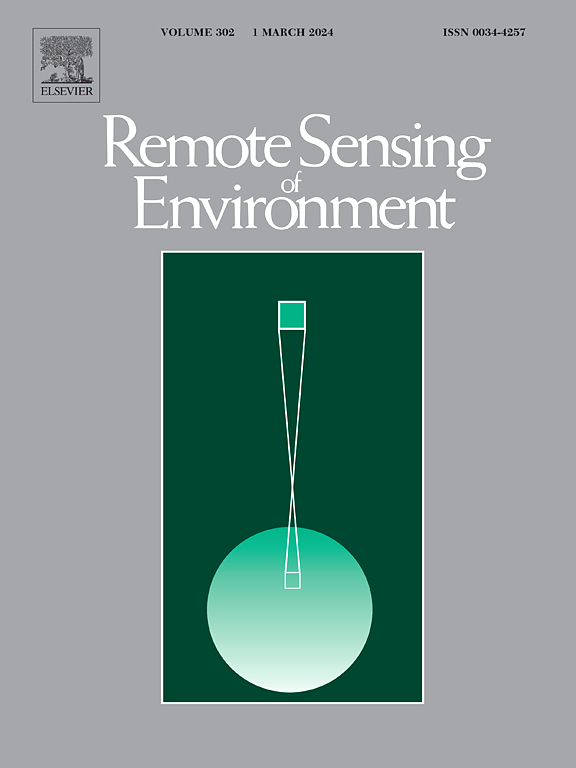Seafloor motion from offshore man-made structures using satellite radar images – A case study in the Adriatic Sea
IF 11.1
1区 地球科学
Q1 ENVIRONMENTAL SCIENCES
引用次数: 0
Abstract
Space geodetic techniques have achieved centimeter to even millimeter precision in measuring earth surface deformation. However, a large data gap remains in the offshore area. Offshore man-made structures (e.g., oil/gas platforms) anchored to the ocean bottom provide an opportunity to study seafloor motion in some areas. Although satellite InSAR (Interferometric Synthetic Aperture Radar) has been widely used to study earth surface deformation, its application to offshore regions is extremely limited. Continuous GNSS (Global Navigation Satellite System) observations at several tens of offshore platforms in the Adriatic Sea have recently been released. Measuring the same platforms with InSAR provides a great opportunity to assess the feasibility of applying this technique to study seafloor motion on a regional scale using offshore structures. We processed a six-year-long time series of SAR images from the Sentinel-1A satellite using the Permanent Scatterer InSAR (PS-InSAR) method. We assessed the feasibility of phase unwrapping using synthetic data with different velocity fields and noise levels. Correct phase unwrapping could be achieved in the Adriatic Sea and two other large offshore oil/gas fields: the Gulf of Mexico and the North Sea. Different calibration strategies were applied, and we suggest that the InSAR results could be calibrated with limited and even no GNSS stations. Our InSAR results show good agreement with the GNSS measurements and the InSAR observations from the European Ground Motion Service. In addition, our InSAR results provide deformation measurements at about twenty offshore structures where GNSS stations are not present. Most of the offshore structures have a subsidence rate of no more than 5 mm/year, while a few of them reach about 10 mm/year. Our work demonstrates that it is feasible to apply the InSAR technique to measure displacement of discrete offshore man-made structures (fixed to the ocean bottom) on a regional scale but still on a case-by-case basis. Pre-acquired information including geological settings, existing geodetic observations, and human activity records (e.g., hydrocarbon production) are useful information to assess the feasibility and to validate the InSAR results.
利用卫星雷达图像分析近海人造结构的海底运动——以亚得里亚海为例
空间大地测量技术在测量地表变形方面已经达到了厘米到毫米的精度。然而,在近海地区仍然存在很大的数据缺口。锚定在海底的海上人造结构(如石油/天然气平台)为研究某些地区的海底运动提供了机会。卫星干涉合成孔径雷达(InSAR, Interferometric Synthetic Aperture Radar)已广泛应用于地表形变研究,但其在近海地区的应用极为有限。最近发布了亚得里亚海数十个海上平台的连续GNSS(全球导航卫星系统)观测数据。利用InSAR测量相同平台提供了一个很好的机会来评估应用该技术在区域范围内利用海上结构研究海底运动的可行性。我们使用永久散射体InSAR (PS-InSAR)方法处理了Sentinel-1A卫星6年时间序列的SAR图像。我们使用不同速度场和噪声水平的合成数据来评估相位展开的可行性。在亚得里亚海和另外两个大型海上油气田:墨西哥湾和北海,可以实现正确的阶段展开。采用了不同的校准策略,我们建议在有限的甚至没有GNSS站的情况下对InSAR结果进行校准。我们的InSAR结果与GNSS测量结果和欧洲地面运动服务处的InSAR观测结果吻合良好。此外,我们的InSAR结果提供了大约20个没有GNSS站的海上结构的变形测量。大部分海上构造沉降速率不超过5 mm/年,少数达到10 mm/年左右。我们的工作表明,在区域尺度上应用InSAR技术来测量离散的近海人造结构(固定在海底)的位移是可行的,但仍然是个案的基础上。预先获取的信息,包括地质环境、现有大地测量观测和人类活动记录(如油气生产),是评估可行性和验证InSAR结果的有用信息。
本文章由计算机程序翻译,如有差异,请以英文原文为准。
求助全文
约1分钟内获得全文
求助全文
来源期刊

Remote Sensing of Environment
环境科学-成像科学与照相技术
CiteScore
25.10
自引率
8.90%
发文量
455
审稿时长
53 days
期刊介绍:
Remote Sensing of Environment (RSE) serves the Earth observation community by disseminating results on the theory, science, applications, and technology that contribute to advancing the field of remote sensing. With a thoroughly interdisciplinary approach, RSE encompasses terrestrial, oceanic, and atmospheric sensing.
The journal emphasizes biophysical and quantitative approaches to remote sensing at local to global scales, covering a diverse range of applications and techniques.
RSE serves as a vital platform for the exchange of knowledge and advancements in the dynamic field of remote sensing.
 求助内容:
求助内容: 应助结果提醒方式:
应助结果提醒方式:


